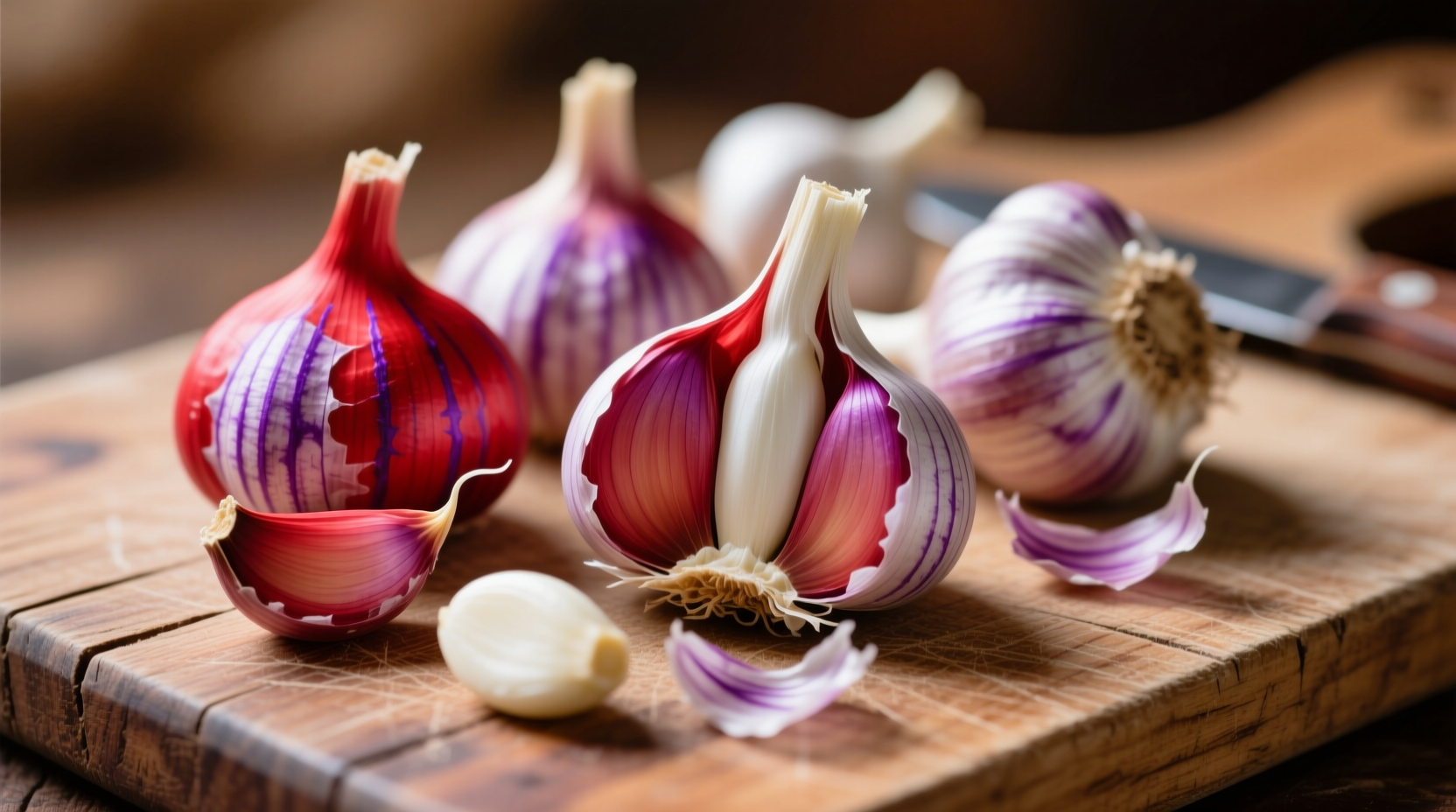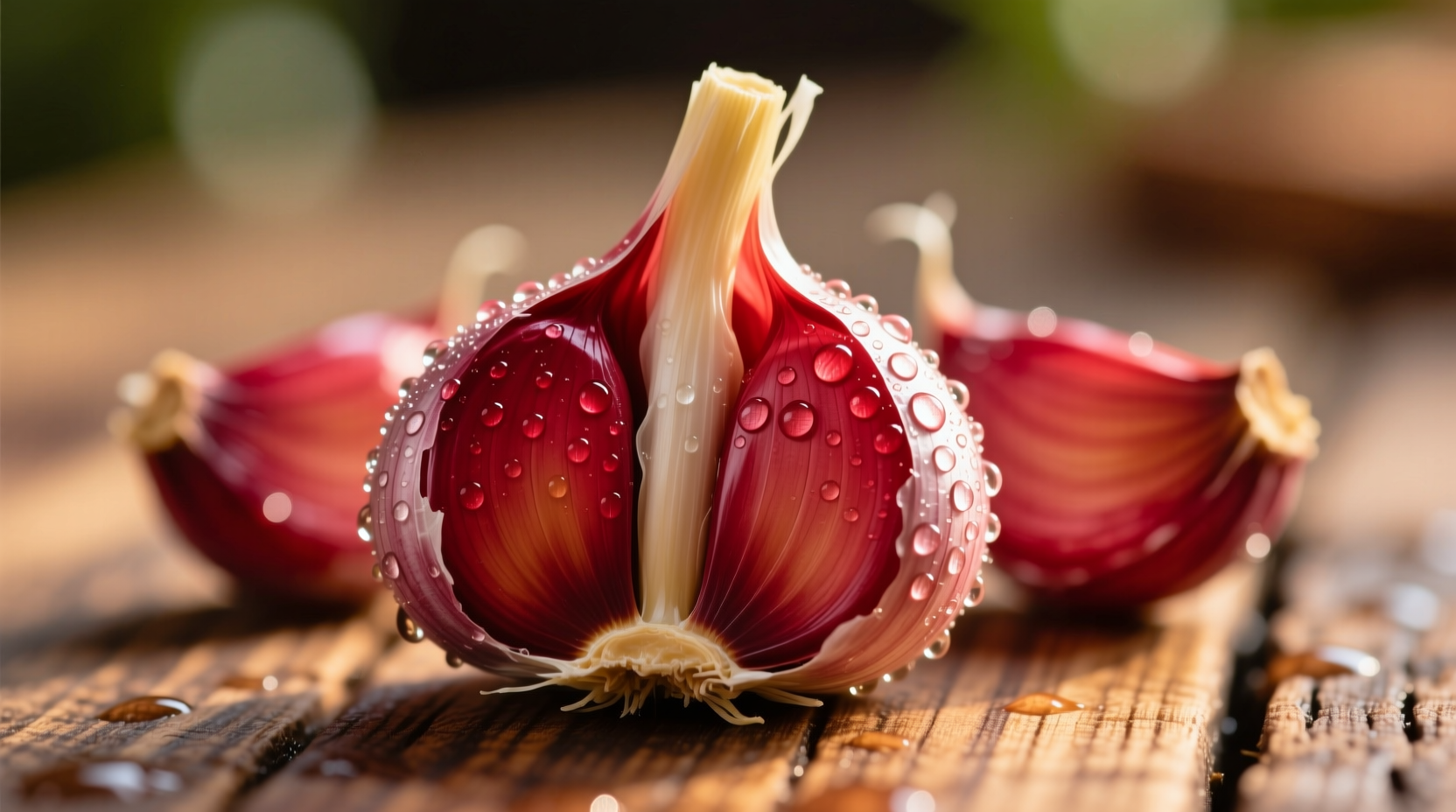Red garlic, also known as purple garlic, is a distinctive variety of Allium sativum characterized by its purple-striped or entirely purple-hued cloves. Unlike regular white garlic, red garlic contains higher levels of anthocyanins—the same antioxidants found in red wine and blueberries—giving it both its vibrant color and enhanced health benefits. This variety typically offers a milder, sweeter flavor profile with less pungency than standard garlic, making it particularly valuable in raw applications and delicate dishes.
When you reach for that bulb with purple streaks at your local market, you're selecting a garlic variety with unique culinary and nutritional advantages. Understanding red garlic's distinctive properties helps you maximize its potential in your kitchen while reaping its health-promoting benefits.
What Makes Red Garlic Different From Regular Garlic?
Red garlic isn't just a visual standout in the produce section—it represents a distinct genetic variation with measurable differences from common white garlic. The purple pigmentation comes from anthocyanins, powerful antioxidants that provide both color and additional health benefits.
| Characteristic | Red Garlic | Regular White Garlic |
|---|---|---|
| Coloration | Purple-striped or entirely purple cloves | White or off-white cloves |
| Flavor Profile | Milder, sweeter, less pungent | Stronger, more pungent, sharper |
| Antioxidant Content | Higher anthocyanin levels | Lower anthocyanin levels |
| Storage Life | Shorter (4-6 months) | Longer (6-8 months) |
| Best Culinary Uses | Raw applications, delicate dishes, roasting | Hearty cooking, long-simmered dishes |
This comparison reflects data from the USDA Agricultural Research Service's Allium variety database, which documents measurable differences between garlic cultivars based on chemical composition analysis.
When to Choose Red Garlic: Practical Culinary Guidance
Understanding red garlic's flavor profile helps you make strategic choices in your cooking. The milder nature of red garlic makes it particularly valuable in applications where raw garlic would typically overwhelm other ingredients.
Raw Applications Where Red Garlic Shines
- Salad dressings – Its subtle flavor blends beautifully with vinaigrettes without dominating
- Garlic-infused oils – Creates a more delicate, nuanced flavor profile
- Bruschetta and crostini toppings – Provides garlic flavor without harshness
- Raw sauces like aioli – Delivers garlic essence with less bite
Situations Where Regular Garlic Might Be Better
While red garlic offers distinct advantages, it's not always the ideal choice. Regular white garlic typically performs better in:
- Long-simmered tomato sauces where stronger garlic flavor is desired
- Garlic bread that benefits from pronounced garlic notes
- Certain traditional recipes where specific garlic flavor profiles are essential
This context awareness helps you make informed decisions based on your specific culinary goals rather than simply choosing based on appearance.
The Evolution of Red Garlic Cultivation
Red garlic has a rich history that spans centuries and continents. Understanding its development provides valuable context for appreciating this distinctive variety.
15th-16th Century: Spanish explorers introduce purple garlic varieties to the Americas from Mediterranean regions
1800s: Documentation of distinct purple garlic strains in California's Central Valley by early agricultural settlers
1940s-1950s: USDA begins formal cataloging of garlic varieties, identifying specific purple-hued strains
1980s: Growing interest in heirloom varieties leads to rediscovery of traditional red garlic cultivars
2000s-Present: Scientific analysis confirms higher anthocyanin content in purple garlic varieties and their associated health benefits
According to research published by the University of California's Agricultural and Natural Resources division, red garlic varieties have experienced a resurgence as chefs and home cooks increasingly value their distinctive flavor profile and visual appeal.
Health Benefits Supported by Research
While all garlic offers health-promoting properties, red garlic's anthocyanin content provides additional benefits. Research from the Journal of Agricultural and Food Chemistry confirms that purple garlic varieties contain significantly higher levels of these beneficial compounds.
The combination of allicin (garlic's primary active compound) with anthocyanins creates a synergistic effect that may enhance certain health benefits:
- Cardiovascular support: Studies suggest the anthocyanins in red garlic may provide additional protection for blood vessels beyond standard garlic benefits
- Antioxidant capacity: The dual antioxidant profile offers broader protection against oxidative stress
- Anti-inflammatory properties: Research indicates potentially enhanced anti-inflammatory effects
It's important to note that these benefits are maximized when red garlic is consumed raw or lightly cooked, as high heat can degrade some of the beneficial compounds.
How to Select and Store Red Garlic
Choosing quality red garlic and storing it properly ensures you get the best flavor and longevity from your purchase.
Selecting Quality Red Garlic
- Look for firm bulbs with tight, unbroken skin
- Check for vibrant purple streaks—more pronounced color often indicates higher anthocyanin content
- Avoid bulbs with soft spots, mold, or green sprouts
- Heavier bulbs typically contain more substantial cloves
Proper Storage Techniques
Red garlic has a shorter shelf life than white varieties due to its higher moisture content. Follow these guidelines:
- Store in a cool, dark, well-ventilated place (not the refrigerator)
- Keep whole bulbs intact until ready to use
- Use within 4-6 months for best quality
- Once peeled, store cloves in an airtight container in the refrigerator for up to 1 week

Maximizing Flavor in Your Cooking
Red garlic's unique properties require slightly different handling to maximize its culinary potential:
Preparation Techniques
- Minced red garlic: Let it rest for 10 minutes after mincing to allow flavor compounds to develop
- Roasting: Whole bulbs roasted at 375°F for 35-40 minutes create a sweet, mellow spread
- Infusions: Gently heat in oil (below smoking point) to create delicate garlic oil
Culinary Pairings That Highlight Red Garlic
Red garlic complements certain ingredients particularly well:
- Seafood dishes where strong garlic flavor might overwhelm
- Spring vegetable preparations like asparagus and peas
- Fresh tomato salads and bruschetta
- Light pasta dishes with olive oil and fresh herbs
Professional chefs often reserve red garlic for dishes where garlic should be present but not dominant, creating a more nuanced flavor profile that enhances rather than overwhelms other ingredients.
Where Red Garlic Fits in Global Cuisines
While garlic is a universal ingredient, red garlic features prominently in specific culinary traditions:
- Mediterranean cuisine: Particularly valued in Spanish and Italian cooking for raw applications
- Asian cuisine: Used in certain Chinese and Korean preparations where milder garlic is preferred
- California cuisine: Features in farm-to-table restaurants emphasizing local heirloom varieties
According to culinary anthropologists at the University of Gastronomic Sciences in Italy, red garlic's historical use in Mediterranean regions reflects traditional knowledge of its more delicate flavor profile being better suited to certain preparations.
Practical Tips for Home Cooks
Integrating red garlic into your cooking routine can elevate your dishes with minimal effort:
- Substitute red garlic in any recipe calling for raw garlic to reduce harshness
- Create a simple red garlic compound butter for finishing proteins and vegetables
- Make roasted red garlic spread for sandwiches and crostini
- Use in place of white garlic when making garlic-infused olive oil for salad dressings
- Try roasting whole red garlic bulbs alongside spring vegetables for a flavorful side dish
Remember that red garlic's milder flavor means you can often use slightly larger quantities than you would with white garlic without overwhelming your dish.











 浙公网安备
33010002000092号
浙公网安备
33010002000092号 浙B2-20120091-4
浙B2-20120091-4